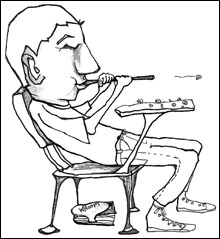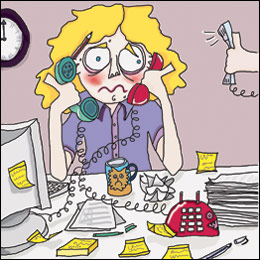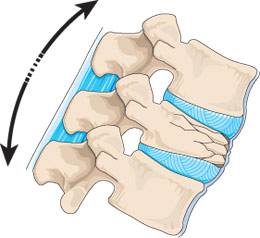What Causes Poor Posture?Growing Up
For generations, youngsters have had to endure a never-ending hassle about their posture from parents and well-wishing relatives. "Straighten up!" or "Don't slouch!" are still the mantra in many households. Teens frequently sabotage what would otherwise be a perfect posture for a variety of reasons, but we often find its origins linked to the rapid changes that normally occur to the bodies of adolescents. Boys may stoop to reduce their newfound height, or just to try to seem less conspicuous, while girls have been known to do the same to hide their budding breasts. Nowadays, other challenges for teens trying to keep their posture abound, including the extensive and intensive use of computers, video games, and the all-pervasive TV, all of which certainly don't help a youngster's stance. Some forms of self-expression teens adopt, like the dark, gothic, hunched-over persona displayed by a certain segment of the high school population, can certainly lead to poor posture. AdulthoodGrown-ups have their own reasons to display poor posture, but fatigue is very likely one of the preponderant causes. Tension and tiredness develop quickly with such day-to-day stressors like work, kids, errands, and bills. Pretty soon the weight of the world rests on one's shoulders; it's no wonder we slump. 
Psychologists may tell you that a less obvious reason adults slouch is that, unconsciously, we use it as a non-verbal means to communicate to our peers and family how we actually feel. We often assume this poor, hunched-over posture and body language as a warning to our colleagues, boss, or spouse that we already have enough work, chores, or responsibilities to do, and we should not be given any more tasks. A fatigued, stooped-over appearance is, in this case, the non-verbal equivalent of "crying uncle." This is, by the way, the only instance I can think of when assuming an artificially good posture could be bad, signaling to others a level of energy beyond a person's real capacity. It doesn't take long, however, for the occasional "I've had enough" slouching stance to become entrenched, a more permanent defect, leading to even more fatigue, misery, and decreased confidence in a self-perpetuating cycle. In addition, the lack of a regimented exercise program is one of the main reasons for the poor posture many adults carry. While most teens can stay in shape without exercise, adults have a harder time keeping their muscle mass, a basic requirement to keep the spine straight. A fitness program becomes a more pressing necessity as we age, but most adults don't really follow one. Many of us, instead, choose to buy an expensive treadmill or a stationary bike, fooled into believing that if we spend enough money on state of the art exercise machines, we'll feel too guilty not to use them; it seldom works and the state of the art equipment often end up as very expensive clothes hangers. "I'm too busy" is the most common excuse adults use to justify the lack of an adequate, solid exercise program when, in fact, a routine of exercises not only improves stamina but also our ability to focus and concentrate, which readily pays off in increased productivity at work and in one's life in general. Bottom line? More time and energy left at the end of the day. Growing Old
This is when things get really complicated. Aging is one of those pre-programmed, built-in functions of every cell contained in the body. The fancy name for cell death is apoptosis, a phenomenon that occurs spontaneously after a cell divides and reproduces a certain number of times. The tips of the chromosomes, the elongated structures inside the nucleus of the cell that contain our body's genetic information, get shorter and shorter each time a cell divides, until it eventually can't divide anymore. This means that all the tissues that compose the body will eventually fail, including bones, joints, and muscles. In the absence of a fountain of youth, people grasp at any new development, tenuous as it may be, to slow down this inexorable aging clock. Desperation turns otherwise smart individuals into easy prey for advertisements that sell anything that even remotely sounds like it could help them, ranging from vitamins and natural/organic foodstuffs to esoteric products that claim that something like "energized water" is the solution to all that ails us. Sadly, despite the devotion of a great many scientists and a sizeable amount of money spent on longevity research, the only proven method that allows an animal to live substantially longer requires a reduction in the number of calories ingested, an average of ten percent less than an animal's daily requirement. Laboratory rats subjected to this very low calorie diet may live twice as long as their counterparts fed regular meals. Scientists are still looking for proof that this diet of partial starvation could be effective and safe for humans. Before you decide to embark on such a regimen, remember that even moderate degrees of malnutrition can cause irreparable damage to the body, decreasing one's defenses against infections and slowing down the metabolism. Stay tuned for further developments. We may not yet know the secret to longevity, but we do have some clues as to what can be done to improve our quality of life, especially on how to feel better through the second half of our lifespan. For starters, we must choose wisely among the myriad of medical and lifestyle options that present themselves to us, seeking only those that would be indeed relevant and meaningful to our health, selecting the ones most likely to benefit us (not an easy task to accomplish in a world of misinformation, media hype, and infomercials). The vast amounts of time, energy, and money spent on catchy but unproven health methods means that less is left to spend on tried and true techniques. 
As humans, we tend to place our limited intellectual and financial resources on the wrong kind of problems. For instance, people worry much more about flying and plane crashes (a relatively rare event), than driving and car accidents (a major, everyday source of disability and death). Beachgoers are more likely to watch out for sharks than riptides, even though the numbers of people who drown are many times higher than those who succumb to Jaws. Similarly, accidents and falls are among the most important preventable causes of disability, but they don't get much airtime on TV. One million osteoporosis fractures occur annually in the US, many times with life-changing consequences. Age leads to muscle atrophy, decreased balance and vision, impaired cardiovascular function, and loss of nerve cells, all contributing to decreased reflexes and consequently to the increased number of accidents observed in mature folks. Accident avoidance is more important for health maintenance than most medical interventions: wearing a seat belt is more likely to benefit us than drinking organic vegetable juices, and holding on to the hand-rail while going downstairs is more useful than an expensive air purifier. One of the top accident prevention measure is the regular use of a fitness program, shown over and over again as among the best, most reliable approach to enhance one's balance and to reduce the number of accidental falls. Many physiologic explanations have been postulated to explain the benefits of this exercise-induced stability, including greater muscle mass and better heart and lung functions, but it seems that the central nervous system may be the greatest beneficiary from such a fitness program. It has been convincingly demonstrated that physical activity does improve and even creates connections between the nerve cells in the nervous system, an actual learning process that happens at a cellular level essentially no different from what occurs when one learns to play an instrument. In addition, it also enhances the blood flow to the brain and increases intellectual capacity. Even lab rats allowed to play and exercise are less likely than their counterparts to develop the so-called amyloid plaques in the brain, a hallmark of Alzheimer's disease. The result is that an exercise routine leads to quicker reflexes, better coordination, improved inner ear function, and decrease in the number of dizzy spells that plagues us as we age, therefore reducing the chances for accidents. |
LifestyleThe Internal Organs and Posture |